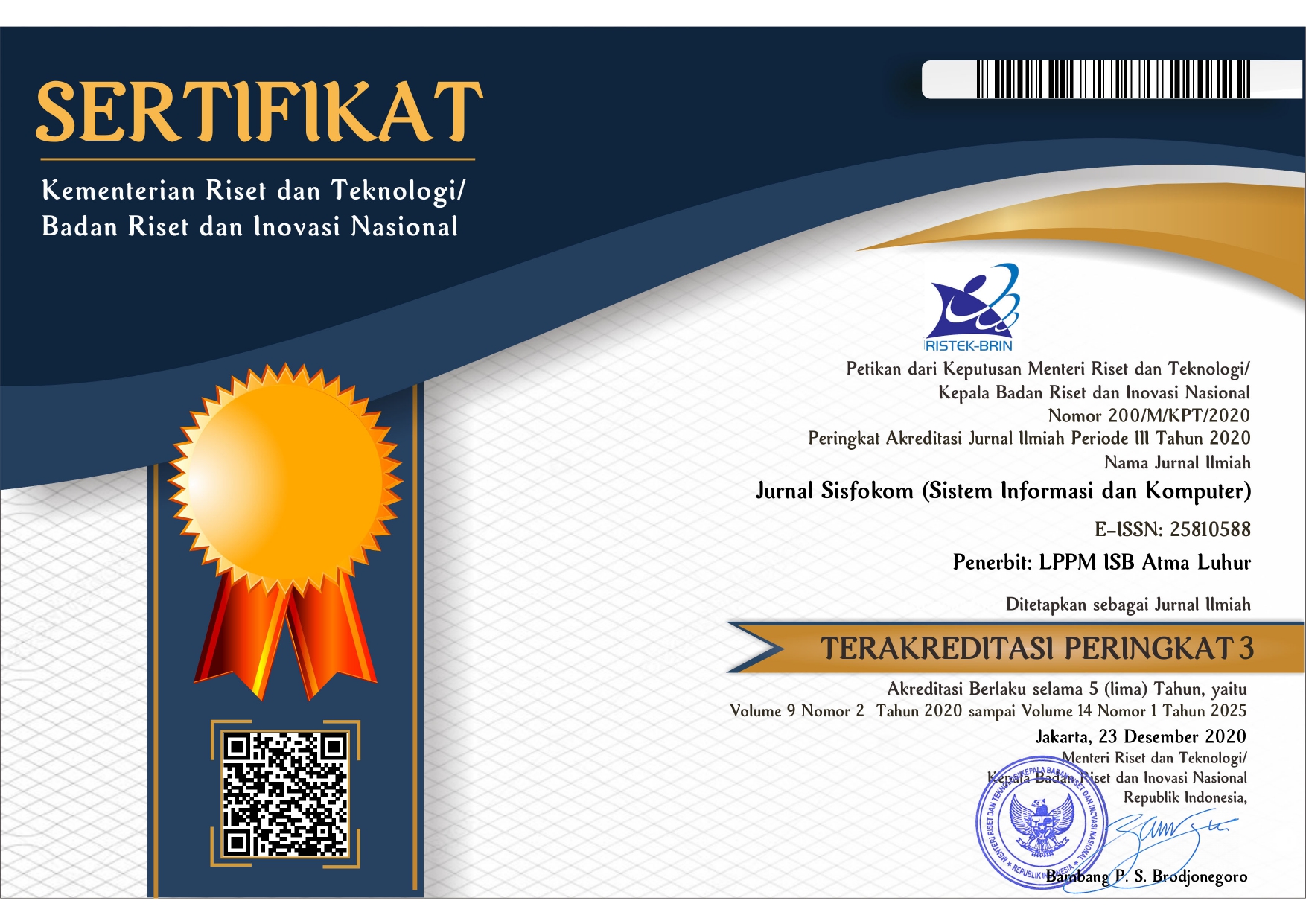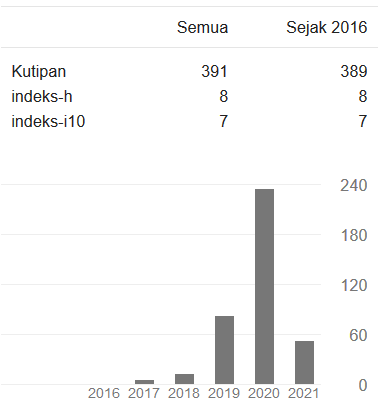Sentiment Analysis of User Reviews on the Game GTA V Using Support Vector Machine
DOI:
https://doi.org/10.32736/sisfokom.v14i3.2368Keywords:
GTA V, Sentiment Analysis, Support Vector Machine, TF-IDF, User ReviewAbstract
This study explores user sentiment toward the game Grand Theft Auto V (GTA V) by analyzing 101,540 user reviews collected from Steam and Kaggle. The reviews were processed using standard text preprocessing techniques including case folding, tokenization, stopword removal, and stemming. The TF-IDF method was used to convert text into numerical vectors, and sentiment classification was conducted using the Support Vector Machine (SVM) algorithm. The model was evaluated with accuracy, precision, recall, and F1-score as performance metrics. Results show that 88.8% of reviews are positive, while 11.2% are negative. The SVM model achieved an accuracy of 94.2% and an F1-score of 94.2%, indicating high reliability. Wordcloud analysis highlights key aspects valued by users such as graphics, story, and gameplay, while negative sentiment is often associated with technical issues like lag and bugs. This study demonstrates the effectiveness of combining TF-IDF and SVM for sentiment classification in the gaming domain, and it offers a scalable approach for understanding public opinion in digital platforms.References
M. Ahmad, S. Aftab, and M. Bashir, “Sentiment analysis using SVM: A systematic literature review,” Int. J. Adv. Comput. Sci. Appl., vol. 9, no. 2, pp. 514–524, 2018.
A. Setiawan and R. Prabowo, “Analisis sentimen ulasan produk marketplace menggunakan TF-IDF dan SVM,” J. SISFOKOM (Sistem Informasi dan Komputer), vol. 12, no. 1, pp. 50–58, 2023.
M. Arinal and B. A. Purnomo, “Optimization of Decision Tree using PSO for GTA V Roleplay sentiment analysis,” J. RESTI, vol. 7, no. 2, pp. 201–209, 2023.
M. H. Aufan, M. R. Handayani, A. B. Nurjanna, N. C. H. Wibowo, and K. Umam, “The perceptions of Semarang five-star hotel tourists with Support Vector Machine on Google Reviews,” J. Tek. Inform. (JUTIF), vol. 5, no. 5, pp. 1241–1247, 2024.
R. Hidayat and N. Setiani, “Twitter sentiment classification using SVM and word embedding,” J. RESTI, vol. 6, no. 3, pp. 489–495, 2022.
R. Iriananda, R. Sofyan, and D. Wahyudi, “SVM parameter optimization for digital product sentiment analysis,” J. RESTI, vol. 7, no. 1, pp. 95–101, 2023.
J. Kim and H. Park, “Sentiment analysis for game review using NLP and deep learning,” IEEE Access, vol. 9, pp. 119042–119054, 2021.
Y. Liao and H. Li, “Improving TF-IDF with semantic similarity for review classification,” Expert Syst. Appl., vol. 168, p. 114292, 2021.
F. Nugroho and R. Kartika, “Implementation of text mining and TF-IDF for mobile game sentiment analysis,” J. RESTI, vol. 5, no. 4, pp. 820–827, 2021.
A. Rahman and L. Susanti, “Performance evaluation of SVM, Decision Tree, and KNN in product sentiment analysis,” J. Teknol. Inf. dan Ilmu Komput. (JTIIK), vol. 9, no. 4, pp. 782–790, 2022.
F. Rizaldi and R. Setiawan, “Sentiment analysis on Tokopedia reviews using Naïve Bayes and SVM,” J. RESTI, vol. 7, no. 3, pp. 497–503, 2023.
J. Y. An, A. S. K. Chow, and C. W. Tan, “A comparative study of machine learning algorithms for sentiment analysis of game reviews,” IEM J., vol. 82, no. 3, pp. 54–60, 2022.
R. A. Wibowo and N. Suryani, “Application of SVM for product sentiment analysis with TF-IDF and Word2Vec,” J. RESTI, vol. 5, no. 1, pp. 12–18, 2021.
N. Yuliani and D. Prasetyo, “Comparison of Naive Bayes and SVM in sentiment analysis of film reviews,” J. SISFOKOM, vol. 10, no. 2, pp. 150–158, 2023.
L. Zhang, S. Wang, and B. Liu, “Deep learning for sentiment analysis: A survey,” Wiley Interdiscip. Rev. Data Min. Knowl. Discov., vol. 10, no. 4, p. e1335, 2020.
M. Curium, “GTA V Steam Reviews Dataset,” Kaggle, 2024. [Online]. Available: https://www.kaggle.com/datasets/matthewcurium/gta-v-steam-reviews-datase
S. Gupta and R. Kumar, “A hybrid model for sentiment analysis of product reviews using TF-IDF and SVM,” Procedia Computer Science, vol. 167, pp. 2417–2426, 2020.
H. Zhang and L. Wang, “Sentiment analysis of game reviews using support vector machine with feature selection,” IEEE Access, vol. 8, pp. 123456–123465, 2020.
X. Li and Z. Liu, “Comparative study of SVM and deep learning models for sentiment analysis of gaming reviews,” Journal of Big Data, vol. 9, no. 1, pp. 1–15, 2022.
M. Rizky and B. Prabowo, “Penerapan machine learning untuk analisis sentimen pada ulasan aplikasi mobile,” J. Teknol. Inf. dan Ilmu Komput. (JTIIK), vol. 7, no. 2, pp. 215–222, 2020.
B. Nugroho and A. Maulana, “Klasifikasi sentimen pada ulasan film menggunakan SVM,” J. RESTI, vol. 5, no. 4, pp. 720–727, 2021.
A. Syafitra and D. Santoso, “Analisis sentimen menggunakan SVM pada ulasan e-commerce,” J. Tek. ITS, vol. 9, no. 2, pp. A106–A111, 2020.
S. R. Alhassan, A. A. Abdurrahman, and M. A. Sadiq, “A machine learning approach for sentiment classification of Nigerian movie reviews using SVM,” Indonesian Journal of Electrical Engineering and Computer Science, vol. 19, no. 2, pp. 543–550, 2020.
Downloads
Published
Issue
Section
License
Copyright (c) 2025 Adika Kaka Saputra, Maya Rini Handayani, Nur Cahyo Hendro Wibowo, Khothibul Umam

This work is licensed under a Creative Commons Attribution 4.0 International License.
The copyright of the article that accepted for publication shall be assigned to Jurnal Sisfokom (Sistem Informasi dan Komputer) and LPPM ISB Atma Luhur as the publisher of the journal. Copyright includes the right to reproduce and deliver the article in all form and media, including reprints, photographs, microfilms, and any other similar reproductions, as well as translations.
Jurnal Sisfokom (Sistem Informasi dan Komputer), LPPM ISB Atma Luhur, and the Editors make every effort to ensure that no wrong or misleading data, opinions or statements be published in the journal. In any way, the contents of the articles and advertisements published in Jurnal Sisfokom (Sistem Informasi dan Komputer) are the sole and exclusive responsibility of their respective authors.
Jurnal Sisfokom (Sistem Informasi dan Komputer) has full publishing rights to the published articles. Authors are allowed to distribute articles that have been published by sharing the link or DOI of the article. Authors are allowed to use their articles for legal purposes deemed necessary without the written permission of the journal with the initial publication notification from the Jurnal Sisfokom (Sistem Informasi dan Komputer).
The Copyright Transfer Form can be downloaded [Copyright Transfer Form Jurnal Sisfokom (Sistem Informasi dan Komputer).
This agreement is to be signed by at least one of the authors who have obtained the assent of the co-author(s). After submission of this agreement signed by the corresponding author, changes of authorship or in the order of the authors listed will not be accepted. The copyright form should be signed originally, and send it to the Editorial in the form of scanned document to sisfokom@atmaluhur.ac.id.









